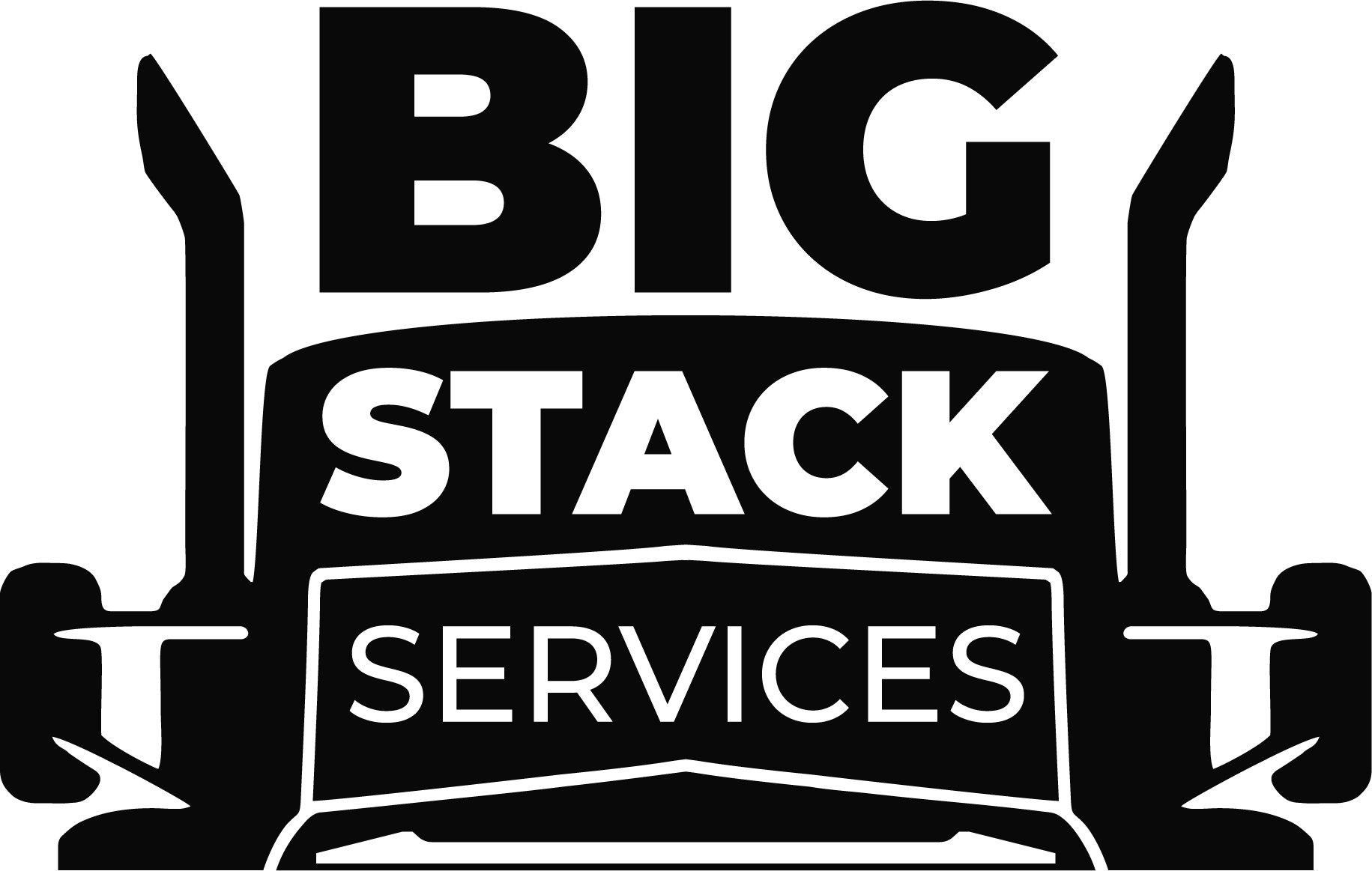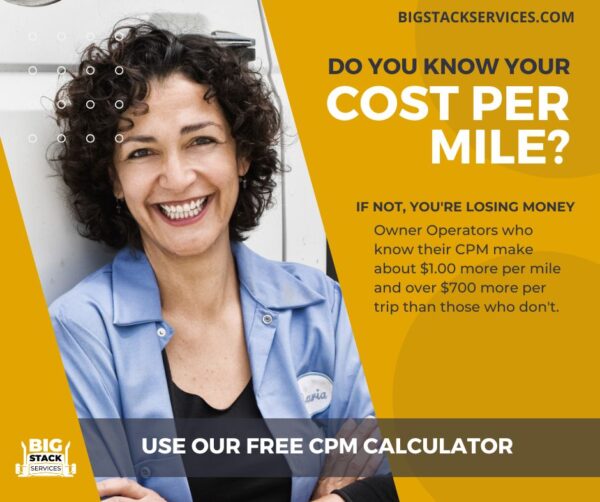Cost-Per-Mile Calculator
Owner operators who know their CPM make about $1.00 more per mile and over $700 more per trip than those who don’t. For truckers, if you want to make money, you have to understand your cost-per-mile. Calculating your cost-per-mile accurately lets you keep your rates competitive, while still making a profit. This guide shows how to calculate your cost-per-mile and gives you practical tips for saving money. If you want to make money, you have to understand your cost-per-mile. Calculating your cost-per-mile accurately lets you keep your rates competitive, while still making a profit. Get a free CPM calculator and stop leaving money on the table.
How to Calculate Your Cost Per Mile
You can always figure out your CPM on your own. You’ll need to account for things like:
- Fixed and variable costs
- Fuel
- Maintenance and repairs
- Insurance
- Permits
- Depreciation and financing
- Miscellaneous expenses
Once you have a handle on what it takes to run your truck, you can make sure to choose loads that cover your costs and let you make a healthy profit.
Know Your Fixed Costs:
Fixed costs are expenses that generally stay the same regardless of the number of miles you drive. These expenses include truck payments, insurance premiums, permits, and licenses. It also includes a base salary for owner-operators. Start by adding up all your fixed costs for a month.
Account for Variable Costs:
Variable costs are directly tied to the number of miles you drive. These costs change based on things like fuel consumption, maintenance and repairs, tires, tolls, and parking fees. They also include percentages paid to carriers, brokers, dispatchers, and factoring companies. To figure out your variable costs, keep detailed records of these expenses every month. This will let you know how much they are for a specific month and also give you an idea of what they’re like over the course of the year.
Fuel Costs:
Fuel expenses eat up a significant part of a truck driver’s income. To find out your average fuel cost per mile, divide your total fuel cost by the number of miles you drove. You can also just enter these numbers into a CPM calculator and it will do the math for you. Keep your fuel costs down by using fuel discount networks, like AtoB, Mudflap, or Multiservice Fuel Card.
Maintenance and Repairs:
Regular maintenance and unexpected repairs are inevitable for any truck driver. Keeping track of these expenses is an important part of calculating your cost-per-mile. Write down all maintenance and repair costs. This includes oil changes, tire replacements, engine repairs, and other related expenses. Divide the total maintenance and repair costs by the number of miles driven to get your average cost per mile for maintenance and repairs.
Insurance and Permits:
Insurance premiums and permits are necessary costs for truck drivers. Add up your annual or monthly insurance premiums. Make sure to include liability, cargo, physical damage coverage, and special permit fees. Divide your total insurance costs by the number of miles you drove to figure out your average insurance cost per mile.
Depreciation and Financing:
If you’re an owner-operator, you have to put in things like the depreciation of your truck and the interest on your financing. Depreciation is how much your truck loses value over time. If you have loans on your truck or trailer, the interest you pay is an important part of this calculation. Add your depreciation and interest up and divide the total cost by the number of miles driven. This gives you the average cost per mile for depreciation and financing.
Additional Expenses:
Besides the costs we already talked about, there are a few other things to keep in mind. Don’t forget about taxes, parking fees, tolls, scale fees, truck washes, and any other miscellaneous costs directly related to your trucking operations. Track these expenses and divide the total by the number of miles driven to calculate your average cost per mile.
Final Calculations:
Once you’ve figured out all the individual costs, add the fixed and variable costs together to get your total operating costs for the month. Divide the total operating costs by the number of miles driven during the month to get your cost per mile. Download our Easy CPM Calculator for Google Sheets and make figuring out your cost-per-mile a breeze. Just put in numbers, and it calculates everything for you.
Optimizing Your Cost-Per-Mile:
Now that you have a clear understanding of your cost-per-mile, you can take steps to lower it and increase your profitability:
-
- Improve Fuel Efficiency: Keep your speed at 65 mph or less. Cut down on idle time and keep your truck tuned up. Make sure your tires aren’t under-inflated. Drive smooth and mellow. And of course, the more you use your AC or heater, the more fuel you burn.
-
- Regular Maintenance: Take care of problems before they happen by doing preventative maintenance on your truck. This will keep your maintenance costs lower and you’ll have less downtime.
-
- Optimize Routes: Good route planning helps you save money and avoid problems. It gets you where you’re going on time and makes sure you know where to find important places like repair shops, tire stores, and places to park. Use apps like Sygic, SmartTruckRoute, and Rand-McNally. For drivers with a lot of stops, consider Road Warrior.
-
- Negotiate Rates: Use your CPM numbers to negotiate better rates with shippers and brokers. The CPM represents the amount of money you need to make just to break even. Make sure you’re agreeing to rates that let you cover your costs and make a solid profit.
-
- Consider Load Optimization: Make the best use of your space, especially with LTL loads. Consider things like how long it’s going to take to load or unload your truck and travel time to make sure you’re not looking at a HOS violation. Some companies are notoriously bad at unloading trucks on time, so if you’re hauling for one of them, factor that into your plan.
-
- Invest in Technology: The right technology can save you money in the long run. Use fleet management systems and fleet trackers to keep an eye on fuel consumption, track maintenance, and improve operational efficiency. Use tools like a CPM calculator to make keeping track of expenses faster and easier.
If you want a profitable business, you have to calculate your cost-per-mile. Accurately tracking and analyzing your expenses gives you an edge and helps you set competitive rates. It increases your profit and lets you make informed decisions. Remember to recalculate your cost-per-mile every quarter. This helps you take into account any changes in your expenses or business circumstances. With a solid understanding of your costs, you’ll be well-equipped to thrive, even in a down market.


